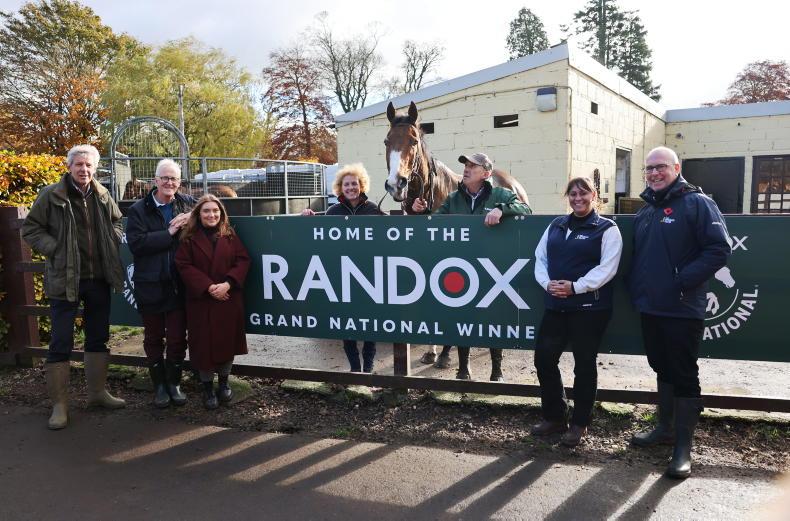“
IF you can keep your head when all about you are losing theirs”.
This line from Rudyard Kipling’s famous poem immediately came to mind after I had concluded my recent interview with Sulekha Varma.
I hope that she will not be offended when I suggest that her name is probably not on the tip of everyone’s tongue in Ireland or Britain, but the fact that it is not also means that she is doing her job well. My few meetings with Sulekha have always been informative, enjoyable and one gets the sense that she is someone who is highly professional – and she is. However, she is far from being invisible and she was recently recognised as the 12th most influential woman in sport in Britain.
Sulekha Varma is the head of racing, and clerk of the course, at Aintree. Next weekend, and for two days before that, she will be the person responsible for the smooth running of the three-day festival of racing there, the undoubted highlight of which will be the £1 million Randox Grand National on Saturday. This will be a Grand National like no other, with significant modifications made to the race.
All these changes have horse welfare at their heart, and are seen by The Jockey Club, which runs Aintree, and the British Horseracing Authority as part of the “continued evolution” of the race. The most talked about change will see the maximum field size reduced for the first time since 1984. With the aim of lessening the risk of incidents during the race, the potential line-up for the Grand National is cut from 40 to 34.
A large amount of focus has always centred on the first fence and the run from the start line, and Aintree has moved the first obstacle 60 yards closer to the start, and the race will begin with a standing start. This is to reduce the build-up of speed for horses arriving at the first fence.
Significantly, after the Grand National off time was previously moved to 5.15pm to maximise a television audience, it reverts to an earlier slot to help ensure Aintree can provide optimal underfoot conditions, alleviating concerns over drying ground throughout the day.
Other changes include alterations to the alignment of the running rail on the inside of the course to assist with the early capture of loose horses and reducing fence 11 by two inches, while horses will no longer be led by a handler on-course during the parade in front of the grandstands.
Amazing history
A key player in making these changes is a lady who, accidentally, has had a life of connections with the race, none of which were then indicators that she would one day play a pivotal role in planning and staging the most famous race in the world. Sulekha takes it all in her stride, and sums up what it all means succinctly. “It’s a race with such an amazing history, and a venue with an incredible history. I am very proud to have the job, and very lucky to work with a fantastic team at Aintree and across The Jockey Club.”
Back to those connections, and it was in Ireland that the first occurred.
Sulekha explains: “So the connections are strange because they are all accidental, but pertinent at the same time. I was nine years old in 1994, and had come with my parents to Dublin. My dad was attending a neurosurgeon’s conference and mum and I went off and visited the Book of Kells and all the usual attractions.
“Later, we sat in the hotel room and on the television was the Grand National. I loved horses and on that trip we made a visit to the Irish National Stud. In the hotel room I saw Miinnehoma and Richard Dunwoody cross the line. It was obviously formative but I just didn’t realise it at the time, and it planted something in my brain.
Placement
“Years later, by pure chance, I had a placement with Lucinda Russell, with whom I would later work full-time. The mum of one of my school friends organized work experience placements for another school, and wanted somebody to test one out in racing to see if it was something she could do for her students. Her daughter Lauren and I were packed off to Lucinda’s for a week. Neither of us had ever ridden racehorses.
“Lucinda jacked up my stirrups a bit and said this is how you ride, and off we went. That first time on the gallops was something special. That feeling will always stay with me. Unfortunately, I was never a great work rider. I think Lucinda would tell you I was distinctly average, but I did enjoy it.”
The spark was lit, and after her time at Durham University doing classical studies (“it’s quite good for pub quizzes”), Sulekha gained a place on the BHA graduate programme. This led immediately to spending an enjoyable time with the Racing Post, and being dropped in at the deep end. “I went in there on my first day, straight into a news meeting, and then it was on to write a story - I had no idea what I was doing.
“There was great people on the team, Bill Barber was on the news desk then, Lee Mottershead was the news editor, and Tony Smurthwaite was around. They were great people to work alongside and learn from and all very supportive, and I went from writing news right through to a double page feature by the time I finished.”
Insight
Time spent working with Arabian Racing provided Sulekha with an insight to what would eventually become her career working with racecourses. “I don’t mean it disparagingly when I describe Arabian Racing back then as a traveling circus. We literally packed up the organisation from the office and travelled to different racecourses each weekend through the summer, run a meeting and move on.
“Part of my role was clerking the meetings, but also in the planning side of things, doing a lot of what the clerk would do in terms of booking and arranging emergency services, making sure programmes were correct, prize money, all those things. That was when I began thinking this might be something I can really make something of. After a couple of years I saw The Jockey Club advertising for a trainee clerk.
“Went for the interview and had a second round interview, both of which I thoroughly enjoyed, which you don’t often say about a job interview. Speaking to Simon Claisse on my first round and then Simon and Kirkland Tellwright on the second round, it just felt I was talking to people with shared interests in the world of work. They offered me the job in October 2009, and I started as a trainee.”
Female clerks
Did Sulekha ever worry as a female about entering a world that is generally seen to be male-dominated? “In all honesty it never actually crossed my mind, it was one of these things that other people often said to me, but I never really thought about it. At the time and even now there are plenty of female clerks.
“Talking about moments that you don’t realise affect you until later on in life, I went racing at Perth and saw Anthea Morshead at work. I saw her with a radio and organising everybody and I wondered what she does. It wasn’t until further down the road that I realised something must have triggered then that there are roles in racing that are not just about riding or training.
“When I first got the job as trainee clerk and had my first role at Market Rasen, there were one or two people who had an issue with my gender and my skin colour. I can count on one hand the people who have ever said anything to me about having an issue with it. As a rule, racing is very open and very welcoming, and people have been incredibly supportive. People will help you, you’ve just got to ask them.
“I always will go out of my way to help others to try to make their way in the industry because there were so many people who did the same for me. I firmly believe in helping the next generation find their way if they want to work in the industry, finding their way into a career and letting them see all the open doors and opportunities. It’s crucial for all of us who work in racing to be part of that.”
Head of racing is a better description
CLERK of the course is an old-fashioned term, so I ask Sulekha to spell out what that role entails in layman’s terms.
“I am clerk of the course, that’s what I’m qualified to do, but head of racing is a better description. It’s taking responsibility for everything related to the sport side of running a racecourse, from race planning, the race programme, prize money, working with owners, trainers, jockeys, and making sure that the facilities are as they should be for everybody.
“Moving to the turf management side, this is really about the relationship with the grounds person, they have the knowledge and are the brains. I have some knowledge of turf management, but it’s their track basically. This encompasses making sure that everything is compliant, fences and hurdles as they should be, and safety and equine welfare is a huge aspect of it.
“The final element is the race day clerk, which I describe as conducting the orchestra. You get all your players, make sure you have the best you could possibly get, make sure that they have the music they need to play, and then make sure that they are all playing in symphony. That’s how it all comes together. The clerk is ensuring that everybody else is doing what they need to do, and they have the tools they need.”
Very proud
Last year was a particularly difficult one for Sulekha and her team with on-course protests, so what does she feel now when she looks back at the events of 12 months ago? “It was an unprecedented experience for all of us, and I am very proud of how the team performed. This is their place of work and you don’t expect something like that to happen where you work. Everybody remained calm, did what was asked of them, and nearly a year on I’m still hugely proud of the team and everything they did to handle the situation.”
Any fears about this year’s running and a possible repeat? “As it stands, we have received no direct threats. But we always prepare for all eventualities and work closely with Merseyside Police who are hugely supportive of Aintree and the Grand National and we take their lead. One of the things that is so special about the Grand National meeting is the people of Liverpool really take it to their heart.”
“Right changes to make at this time”
LOOKING to the future, does Sulekha feel there is a fine balance between retaining the integrity and history of the Grand National, and making changes to appease those who oppose it and racing?
“I sort of give that a partial yes. There’s an onus on us to evolve the race while still maintaining its unique nature, and it is unique.
“The reasoning behind looking at the race in more depth last summer was largely because it’s been 10 years since the changes to the fences. We wanted to analyse what the data was telling us about where the race is now as a result of those changes.
“We review the race every year, that’s a given, but that 10-year span gave us an opportunity to really look closely, and to talk to people inside and outside of racing, whether they be trainers, jockeys, BHA officials, vets, welfare organisations, about where they see the Grand National now, and balance that opinion against the data analysis.
Appeal
“I would say that Grand National is a race that has never stood still. That was part of the process for me, going back over the changes that have been made to the race, right back to changing venue, becoming a handicap, restriction on field size, introduction of veterinary checks, and then the tightening of the conditions for horses and riders to take part. Through all of that the race has not lost its appeal.
“We need to protect the opportunity for the special moments that the Grand National creates every year. The fences are still fantastic, they are still formidable, but they are a lot safer and that is the way it should be.
“Of the current changes, I’d probably rank them all equally because otherwise we wouldn’t have put them all forward. If there was one that stood out above the others, we probably would have just have done that one. They were the right changes to make at this time.”


 This is a subscriber-only article
This is a subscriber-only article
 It looks like you're browsing in private mode
It looks like you're browsing in private mode











SHARING OPTIONS: